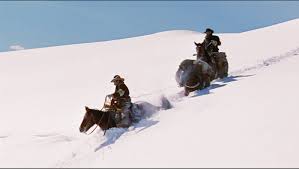Destry Rides Again doesn’t take itself too seriously.  That’s got a lot to do with the director, George Marshall, who went from making traditional Westerns during the Silent era to making comedies with Laurel and Hardy (among others) in the 1930s. Here he assembles a quirky cast, actors you wouldn’t expect to see in the same picture.
That’s got a lot to do with the director, George Marshall, who went from making traditional Westerns during the Silent era to making comedies with Laurel and Hardy (among others) in the 1930s. Here he assembles a quirky cast, actors you wouldn’t expect to see in the same picture.
Jimmy Stewart plays himself, as always: sweet, uncomplicated, as decent as they come. You’d expect Marlene Dietrich to eat him for breakfast. The character she plays, Frenchy (those naughty Frenchwomen, even one with a German accent!), chews up the little Russian (Mischa Auer) in the first ten minutes of the film. He’s highly susceptible to her charms, and she convinces him to gamble away his pants, just for yuks. His wife is not too pleased about it, when he comes home.
Lily Belle : Hey you! Give me those pants. And from now on, leave my husband alone.
Frenchy : I don’t want your husband, Mrs. Callahan – all I want is his money. . . and his pants.
Lily Belle : And how’d you get ’em? By making eyes at him while you cheated, you gilded lily!
Frenchy : But Mrs. Callahan, you know he would rather be cheated by me than married to you.
Fresh from playing a Russian ballet master opposite Jimmy Stewart in You Can’t Take it With You (1938), Auer delivers a delightful performance here. What’s a Russian doing in the old West, alongside a “French” dance hall chanteuse? Who cares!  Marshall makes this ensemble piece sparkle. I like Jimmy Stewart’s folksy sheriff’s deputy better than the congressman he went on to play that same year in Mr. Smith Goes to Washington. He’s less uptight, succumbing to Frenchy, surprising himself, and you like him better for it. Supposedly the two stars had a brief romance on the set. Nobody could resist Dietrich.
Marshall makes this ensemble piece sparkle. I like Jimmy Stewart’s folksy sheriff’s deputy better than the congressman he went on to play that same year in Mr. Smith Goes to Washington. He’s less uptight, succumbing to Frenchy, surprising himself, and you like him better for it. Supposedly the two stars had a brief romance on the set. Nobody could resist Dietrich.
Marshall directed a remake with Audie Murphy in the title role in 1954. Skip it and watch one of the eleven episodes of “I Love Lucy” he directed instead.



 of white innocence (as was Doris Day, and Grace Kelly in High Noon).
of white innocence (as was Doris Day, and Grace Kelly in High Noon).  I’ve read that the movie is routinely used in classics courses, to make the lessons of great epics such as the Iliad, Odyssey, and Aeneid accessible to undergraduates. Achilles, the hero archetype of Homeric legend, is isolated, set apart by his divine origins. Too perfect for the ordinary world.
I’ve read that the movie is routinely used in classics courses, to make the lessons of great epics such as the Iliad, Odyssey, and Aeneid accessible to undergraduates. Achilles, the hero archetype of Homeric legend, is isolated, set apart by his divine origins. Too perfect for the ordinary world.

